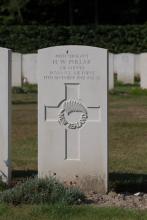"The human remains of a Southland World War II airman, shot down in Germany 79 years ago, have been discovered at the wreckage site.
DNA testing has confirmed the remains, found buried amongst parts of a British World War II bomber plane that went down in 1942, were of Otautau man sergeant Henry Pullar.
His niece Pam Compton said she and her family received written confirmation of the test results from Hamburg-Eppendorf University Hospital biologist Oliver Krebs in late December, 2020. ...
Discovery of the human remains and parts of the plane's tail section, buried more than five metres deep, were made in 2019, while redevelopment work was being done at Vechta Airport in Germany. Research by Compton showed the plane crashed tail first into the ground.
Pullar was a rear gunner in the plane.
News of human remains being found reached Compton in September 2019, after a German aviation archaeology working group member, Jens-Michael Brandes, posted a message on an ancestry site looking for relatives of Errol Skeggs – Compton’s father.
The group was called to the redevelopment site when aircraft parts started appearing during earth moving work.
On the third day of examining the area clothing and human remains were found. A senior archaeologist at the Lower Saxony state office for preservation of cultural heritage became involved in the findings, along with anthropologists of the forensic department of the University Medical Centre in Hamburg-Eppendorf.
Archaeologists, anthropologists and scientists at the site of where the human remains of Southland airman Henry Pullar were discovered at Vechta in Germany in 2019. The British bomber plane Pullar was in was shot down during World War II.
“As more remains were found the forensic scientists from UKE Hamburg came to the site and removed them,” Compton said.
The bones were transferred to Hamburg-Eppendorf University Hospital, where biologist Oliver Krebs subsequently removed DNA from them.
“My family and I and the family and friends of the crew requested that the UK Ministry of Defence Joint Casualty & Compassionate Centre do DNA testing,” Compton said.
She had contacted and built up a network with the relatives of the other airmen after starting research on the life and war service of her uncle in 2016.
DNA samples from Compton and four others in her family were sent to Krebs who later confirmed the bones belonged to her uncle. Krebs sent official confirmation to Compton by email on December 23, 2020.
An aviation archaeology working group member, Matthias Zeisler, at the site in Vechta, Germany, in 2019, where parts of a British World War II plane and remains of Southland airman sergeant Henry Pullar were discovered. DNA testing confirmed the remains belonged to Pullar.
The bones are still at the university’s forensic science department and will be kept there until the Commonwealth War Graves Commission is allowed, under Covid-19 regulations, to take them to Rheinberg War Cemetery in Germany. The bones will be placed in the communal grave which has the remains of five of the six other airmen on the plane.
The pilot has his own grave there.
“It’s a privilege to have found him [Pullar] after all this time, and to have closure when so many didn’t,” Compton said.
Pullar, at 25, was the oldest of the seven crewmen on the British Short Stirling heavy bomber.
Identifying the plane and its crew was done from the personal details found on the pilot’s body which was thrown from the plane just before the crash, Compton said.
The crew was initially buried in a Protestant cemetery in Vechta before being moved to the Rheinberg War Cemetery.
Queensland woman Pam Compton, formerly of Otautau, has closure in knowing DNA testing on human remains discovered through earth moving work in Germany belong to her uncle, sergeant Henry Pullar. The British bomber plane he was in was shot down at Vechta Airport in Germany during World War II.
They each have a headstone at Rheinberg.
Pullar worked on his family’s farm before enlisting in the Royal New Zealand Airforce in March, 1941, at the age of 23. He started his training at Levin and then went to Canada to join the Empire Air Training Scheme.
He was a member of the 75 NZ Squadron RAF and after more training in the UK, was posted to Newmarket in Suffolk." [Source: https://www.stuff.co.nz/national/124416572/remains-of-southland-wwii-gun... accessed: 18/04/2022]



